
August 22nd, 2003
Aero Wars 2003!
The Carrera
Plymouth Superbird and Dodge Daytona
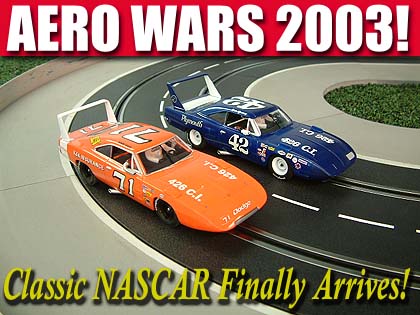 I
ask that you please excuse me for I am slightly excited about this review to say
the least. For some these models mean nothing...for myself they are the end
result of years of waiting and many hours of research. There isn't a slot car
built today that I have wanted more than these Mopars of yesteryear and now
finally they have arrived in all their glory! With that said, let's put the
hammer down shall we?
I
ask that you please excuse me for I am slightly excited about this review to say
the least. For some these models mean nothing...for myself they are the end
result of years of waiting and many hours of research. There isn't a slot car
built today that I have wanted more than these Mopars of yesteryear and now
finally they have arrived in all their glory! With that said, let's put the
hammer down shall we?
The late 60's and early 70's for stock car racing are perhaps my favorite. Massive horsepower coupled with striking liveries on machines that had what is missing today (In my opinion of course)...Identity. During the 1969 and 1970 seasons Chrysler built 3 different cars to trade paint with the best Ford had to offer. Two of these creations shown here were not only very successful but have become the symbol for classic stock car racing. As quickly as they were made, restrictions in 1971 all but killed these Aero machines but the legacy they left behind was one of the fastest and most colorful in series history.
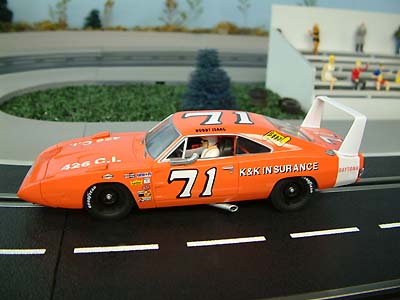
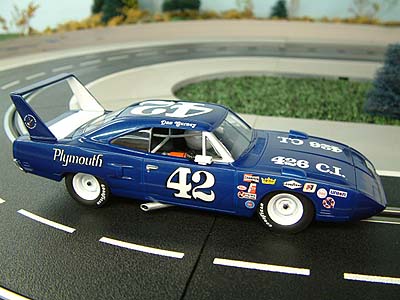
And now we have them in 1/32nd scale! For the hardcore scale enthusiast you might find a few discrepancies but to be honest you will have to look close. Carrera has done a great job in capturing these winged warriors in scale and while on the track racing they accomplish this mission even better. Before you ask...no I have not bothered to measure them. I have stated before that my level of fun does not include a slide ruler or Micrometer and such is the case now. I placed these models on our Artin road course and they race and look perfectly in 1/32nd scale and that is all that matters for my un-calibrated eyes. Overall body shape captures the prototypes very well with crisp mold lines and distinctive differences in both models.
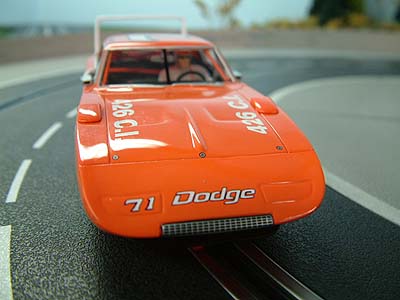
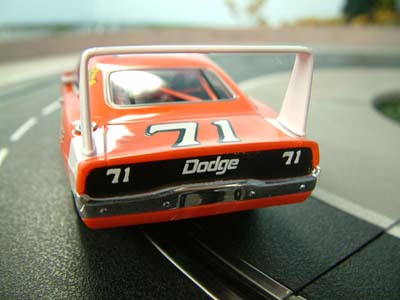
Body color and markings are also very close, as it can depend on what photos of the prototype you look at. Bobby Isaac's Dodge seems a little on the orange side compared to some photos but still is a acceptable representation of the 1:1 car. According to the photos I have both from the internet and from books I have collected over the years, the placement of the markings and such will vary and almost impossible to match perfectly. Given this I feel Carrera has matched them extremely close. Once again, I like to allow the photos to tell the tale. Although these are pre-releases all of these markings were clean and crisp and sealed with an even, dirt and dust free clear-coat. It is interesting to note that on both models the number markings almost appear to be actually very thin decals placed over a Tampo back round. I cannot confirm this however, and I only mention it as some of you might notice this right off. If these are actually Tampo, then they are the thickest ones I have ever seen.
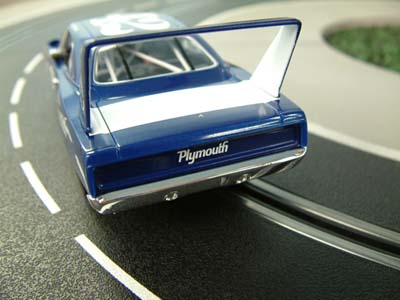
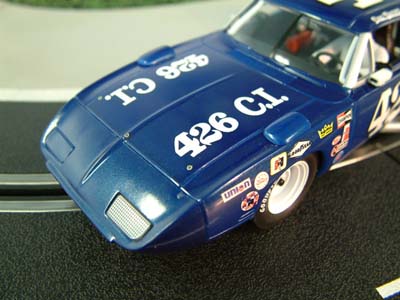
The interior in these models should be enough to please most enthusiasts with details such as roll cage, fire bottle and driver. I was pleased to see that this driver has dimensions and helmet shape that appears a very close match to their 1:1 counter-part. Again, this is not a full interior just a half-tray type design, yet I feel it accomplishes the intended goal nicely. Items such as the air vent hoses mounted on both sides of the model are not found in abundance on all prototypes but were used sporadically depending on the temperature and what track they raced that weekend.
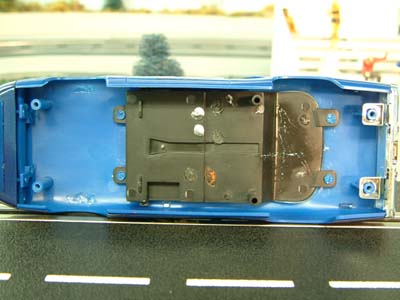
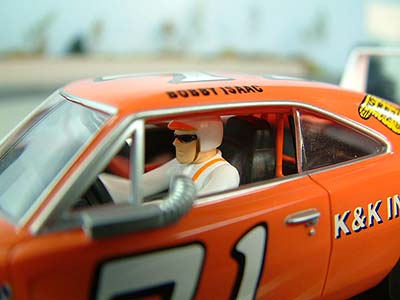
Wheels and tires on all of these models were very round and true and closely match prototype photos. I did need to sand these tires a little to get them where I wanted them, and once sanded they performed even better. Carrera has also mounted the body as close as they could to match the prototype and I happily found that although they are this close, they do not rub. Tire compound is not as soft as some found on other models yet still provided decent grip.
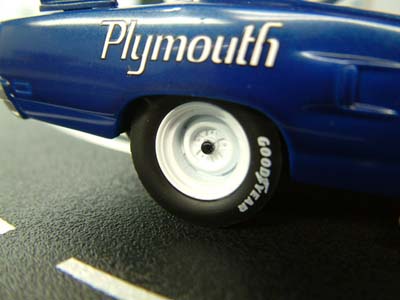
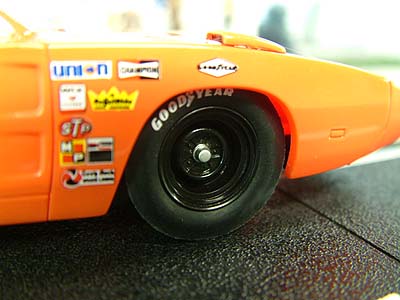
Underneath we can see the new Carrera magnet in the rear of the car along with the adjustable magnet near the center. It is here that we soon discovered an issue that really hurts this model...yet is easily fixed. Unlike other early releases by Carrera with the new chassis, these have the new magnet so low that out of the box on our flat Carrera oval the model just sat there and spun the tires because the magnet bracket is so low it touches the rails and lifts the car off the track. Upon closer inspection and making sure the magnet bracket was fully seated, we chose to remove the shim under the magnet to allow for more clearance.
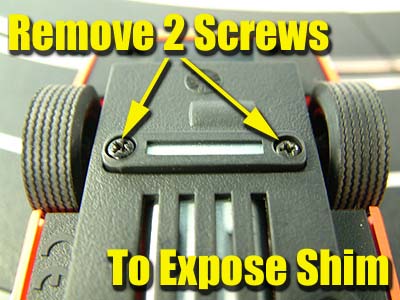
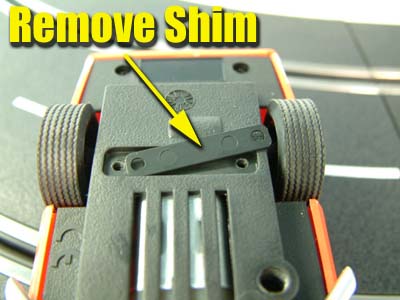
Removing this shim was all it needed to work perfectly. It is still very low and you will most likely find that it still might touch the rails on such track pieces as the molded bridges. You can gain even further clearance by removing the magnet mounting bracket altogether and just Super Glue the magnet in place. I left mine with the bracket on and the shim removed. Again, these are pre-releases and perhaps this will be non-existent in the final product. I can only hope that it is looked at seriously for when these cars come into the hands of the newcomer this might not be the lasting impression we want to leave with them.
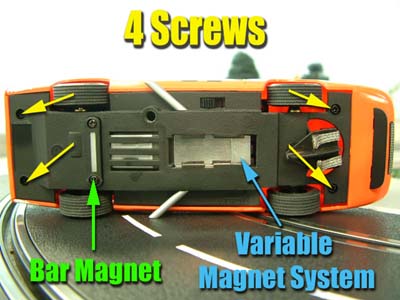
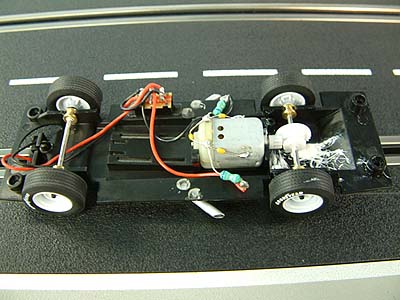
Time to get under the hood! 4 screws are easily removed to expose the new Carrera chassis, motor, wiring and gearing. The new 26,000 rpm motor sits in the inline configuration with a 9 tooth pinion driving a 27 tooth spur gear. You can see the electronics for the polarity switch and the new brass bushings for both the front and rear axles. I was pleased that there was virtually no side-to-side free-play in either the front or rear axles and that the rear gear mesh was smooth as silk. The front guide does have a slight amount of free-play but nothing really major in my eyes and more importantly the guide sits nicely flush with the rails. It could perhaps be lowered slightly but it sits well enough that during testing de-slotting was not an issue.
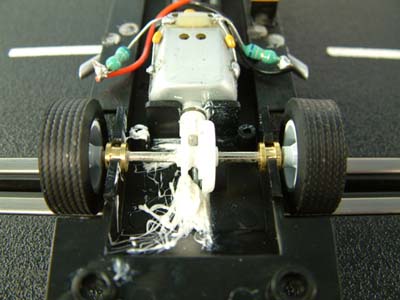
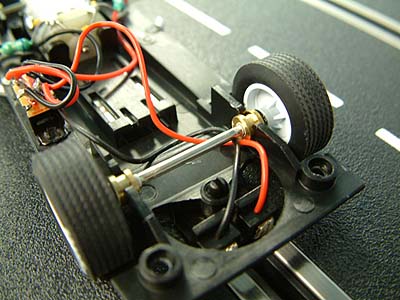
Carrera certainly wants to make sure these cars are well lubricated given the new brass bushings as you can see by the photos. I know many enthusiasts are ardent fans of brass bushings in our models today, but you need to make sure you lubricate them to prevent any damage to the axle or bushing once this initial grease has worn out. These bushings snap very firmly into the chassis and I did not see the need to glue them in place as we noticed no spinning of them under load.
If speed equals performance for you then these models will deliver. We posted lap times on our Carrera track of an average of 3.1 seconds with a best lap of 2.93. This was accomplished with the variable magnet in the rear position with no other modifications other than tire truing. If performance means more to you than just pure speed this model should also satisfy.
All of our test models ran whisper quiet which seems to be a running trait of the recent Carrera releases. It is smooth to operate although some might feel it lacks significant punch during acceleration. This is mostly due to the amount of magnet in these models as removing the rear bar magnet allowed the car to launch out of our corners more aggressively. Braking is more distinct than before due to the new gearing and again the stronger magnets help increase this action.
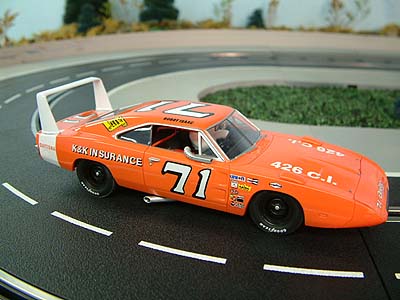
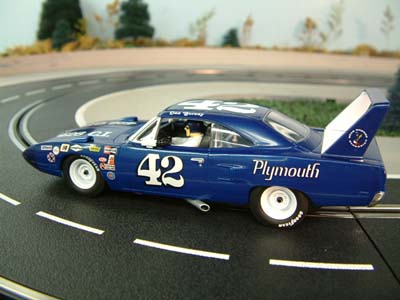
Bottom line for me is that they are a blast to drive! Although I am no fan of strong magnets I still managed to get the tail out on these beasts ever so slightly before she would break free. The recovery time is very short but if my old reflexes can manage it...I think anyone can! Removing the rear bar magnet and setting the variable magnet to the far front position is where I like it and I cannot tell you how much fun I feel they are with this set-up. Silicone tires will make life that much better for those who like to run without magnets, and for those speed-crazed individuals looking for even better lap times. Luckily they are already in development and as soon as I get a pair I will test these models again in both magnet and non-magnet configurations.
One thing that might be an issue for some of you is how durable these models are. Lets face it, the addition of these strong magnets make crashes that much harder and you will most likely see some damage over time. The rear wing is durable enough to withstand some heavy tumbles as I soon found out, but you can easily remove this wing as it is not glued in place. I have had the wing pop off on its own in several tumbles without damage to the mounts but I am sure this kind of hard racing will eventually lead to them breaking.
I am sure fans of classic NASCAR will be pleased with this effort and I highly advise getting some on order soon. Plus, don't think for a second these will be the only liveries available as more are already being planned which will just make it that much easier to create a whole new racing series. To make things even better for fans of this series the Dodge Charger 500 and Plymouth Road Runner are also due for release at the same time instantly giving us an even larger field to do battle!
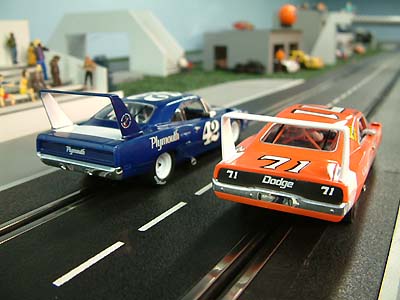 In
the end I am more than pleased with these models. Perhaps I am the wrong person
to even do this review as my love of these machines might be interfering...but I
don't think so. I have said before that decent scale detail combined with a
smooth drive-train usually make up a good slot car and such is the case here.
Although some might disagree, my hat is off to Carrera for their efforts and
feel they have done a splendid job indeed!
In
the end I am more than pleased with these models. Perhaps I am the wrong person
to even do this review as my love of these machines might be interfering...but I
don't think so. I have said before that decent scale detail combined with a
smooth drive-train usually make up a good slot car and such is the case here.
Although some might disagree, my hat is off to Carrera for their efforts and
feel they have done a splendid job indeed!
- Harry
As always feel free to contact me about this article or just the hobby in general at harry@homeracingworld.com, or better yet drop into our Message Forum and share your thoughts with other enthusiasts!
I would like to thank Carrera and LGB of America for providing us with these great models!